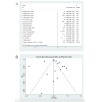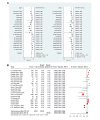Accuracy of Machine Learning in Detecting Pediatric Epileptic Seizures: Systematic Review and Meta-Analysis
- PMID: 39661965
- PMCID: PMC11669868
- DOI: 10.2196/55986
Accuracy of Machine Learning in Detecting Pediatric Epileptic Seizures: Systematic Review and Meta-Analysis
Abstract
Background: Real-time monitoring of pediatric epileptic seizures poses a significant challenge in clinical practice. In recent years, machine learning (ML) has attracted substantial attention from researchers for diagnosing and treating neurological diseases, leading to its application for detecting pediatric epileptic seizures. However, systematic evidence substantiating its feasibility remains limited.
Objective: This systematic review aimed to consolidate the existing evidence regarding the effectiveness of ML in monitoring pediatric epileptic seizures with an effort to provide an evidence-based foundation for the development and enhancement of intelligent tools in the future.
Methods: We conducted a systematic search of the PubMed, Cochrane, Embase, and Web of Science databases for original studies focused on the detection of pediatric epileptic seizures using ML, with a cutoff date of August 27, 2023. The risk of bias in eligible studies was assessed using the QUADAS-2 (Quality Assessment of Diagnostic Accuracy Studies-2). Meta-analyses were performed to evaluate the C-index and the diagnostic 4-grid table, using a bivariate mixed-effects model for the latter. We also examined publication bias for the C-index by using funnel plots and the Egger test.
Results: This systematic review included 28 original studies, with 15 studies on ML and 13 on deep learning (DL). All these models were based on electroencephalography data of children. The pooled C-index, sensitivity, specificity, and accuracy of ML in the training set were 0.76 (95% CI 0.69-0.82), 0.77 (95% CI 0.73-0.80), 0.74 (95% CI 0.70-0.77), and 0.75 (95% CI 0.72-0.77), respectively. In the validation set, the pooled C-index, sensitivity, specificity, and accuracy of ML were 0.73 (95% CI 0.67-0.79), 0.88 (95% CI 0.83-0.91), 0.83 (95% CI 0.71-0.90), and 0.78 (95% CI 0.73-0.82), respectively. Meanwhile, the pooled C-index of DL in the validation set was 0.91 (95% CI 0.88-0.94), with sensitivity, specificity, and accuracy being 0.89 (95% CI 0.85-0.91), 0.91 (95% CI 0.88-0.93), and 0.89 (95% CI 0.86-0.92), respectively.
Conclusions: Our systematic review demonstrates promising accuracy of artificial intelligence methods in epilepsy detection. DL appears to offer higher detection accuracy than ML. These findings support the development of DL-based early-warning tools in future research.
Trial registration: PROSPERO CRD42023467260; https://www.crd.york.ac.uk/prospero/display_record.php?ID=CRD42023467260.
Keywords: EEG; children; deep learning; detection; electroencephalogram; epilepsy; epileptic seizures; machine learning; pediatrics.
©Zhuan Zou, Bin Chen, Dongqiong Xiao, Fajuan Tang, Xihong Li. Originally published in the Journal of Medical Internet Research (https://www.jmir.org), 11.12.2024.
Conflict of interest statement
Conflicts of Interest: None declared.
Figures






References
-
- Fisher RS, van Emde Boas W, Blume W, Elger C, Genton P, Lee P, Engel J. Epileptic seizures and epilepsy: definitions proposed by the International League Against Epilepsy (ILAE) and the International Bureau for Epilepsy (IBE) Epilepsia. 2005;46(4):470–472. doi: 10.1111/j.0013-9580.2005.66104.x. https://onlinelibrary.wiley.com/doi/10.1111/j.0013-9580.2005.66104.x EPI66104 - DOI - DOI - PubMed
-
- Zhang Y, Yang S, Liu Y, Zhang Y, Han B, Zhou F. Integration of 24 feature types to accurately detect and predict seizures using scalp EEG signals. Sensors (Basel) 2018;18(5):1372. doi: 10.3390/s18051372. https://www.mdpi.com/resolver?pii=s18051372 s18051372 - DOI - PMC - PubMed
-
- Tran LV, Tran HM, Le TM, Huynh TTM, Tran HT, Dao SVT. Application of machine learning in epileptic seizure detection. Diagnostics (Basel) 2022;12(11):2879. doi: 10.3390/diagnostics12112879. https://www.mdpi.com/resolver?pii=diagnostics12112879 diagnostics12112879 - DOI - PMC - PubMed
-
- Valencia I, Lozano G, Kothare SV, Melvin JJ, Khurana DS, Hardison HH, Yum SS, Legido A. Epileptic seizures in the pediatric intensive care unit setting. Epileptic Disord. 2006;8(4):277–284. http://www.john-libbey-eurotext.fr/medline.md?issn=1294-9361&vol=8&iss=4... - PubMed
Publication types
MeSH terms
LinkOut - more resources
Full Text Sources
Medical

